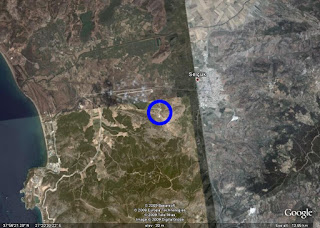I'll be writing more about Ephesus from time to time in this blog because Nicolaos and Diotima visit there in their second book. They've walked the roads and visited the places you see in this picture.

Sadly, Ephesus died, as you can tell, and was abandoned. The reason was silt build up in the harbor, which eventually reached the point where no ship could reach the city. Without ships, trade died. Without trade, the city died.
The semi-circular white blob in the top middle is a huge amphitheatre with astounding acoustics. I know, I've walked these ruins. The almost-horizontal white line running from the amphitheatre is the road to where the docks used to be. The left end of the road, which seems to stop abruptly, is where the docks would be if silt had not destroyed the harbor. As you can see, it's now land.
Here's how much of a silt problem Ephesus had. I've put a circle around the ancient city.

Remember, this was a major port in the Greek world. Anyone who thinks a changing planet is a modern problem should take a close look at this picture.

2 comments:
Wow, that is very crazy and very interesting.
Hi! What a great post. That's a lot of silt.
Best wishes,
Skeeter
Post a Comment